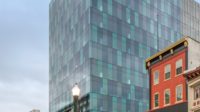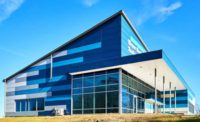Renovation of the 55-year-old Solheimslien Housing Cooperative was recently completed, transforming a tired housing project into an aesthetic gem that gives a boost to a Norwegian coastal city.
After a long period of decline and minimal maintenance, the board of the Solheimslien Housing Cooperative in Bergen decided to completely renovate the project’s eight buildings, choosing architect Lena Beate Keilegavlen with Arkitektgruppen CUBUS AS, who was assigned the task to upgrade the visual expression of Solheimslien.
“The housing cooperative is situated at the foot of a mountain, and there is quite a bit of shade in addition to heavy rainfall—that wears on a building,” said Keilegavlen. “Therefore, it was important that the buildings and façade panels should be as durable and maintenance-free as possible, especially with regard to plant growth and moisture."
One of the key elements in the eight blocks’ rebirth was the use of colorful panels to transform the building envelopes. By using Steni Colour façade panels, the architects chose from 60 standard colors in three gloss levels. The solution was to create a natural expression inspired by the seasons, which easily fits into the surroundings. And Steni’s 60-year warranty was a deciding factor for both durability and longevity.
“Most of the façades are dark grey, highlighted with an interplay of various red, yellow, orange and green tones” Keilegavlen said. “The buildings are located at the foot of the mountains bordering the city and the colors were chosen to make the façades contrast with the foliage of the different seasons.”
The Solheimslien housing cooperative was built in 1966 in the Årstad district of Bergen. The cooperative has 320 units and comprises eight blocks of flats, including five low blocks and three high blocks. After two renovation projects in 1992 and 1998, at the Annual General Meeting in 2013 the board established a building committee that was to handle the renovation process on behalf of the housing cooperative. The project was completed in 2021.
Even with a limited budget, the housing cooperative was transformed into an aesthetic gem that gives a boost to the city. Former resident Anne Lise Sæterdal said the upgrade of the buildings provides a boost for the entire Løvstakksiden neighborhood. “You can see the buildings from large parts of the city, at the same time as they are not too dominant in their surroundings,” she said. “The colors of the gables give life and identity to the area, and the architects deserve special credit for the design turning out so well.”
As a façade product range, Steni Colour includes 60 standard colors and three gloss levels, and almost any custom color based on NCS or RAL can be specified, enabling a designer limitless creative options and styles.
The panels are installed as ventilated cladding and can be installed at any time of year, irrespective of the temperature and weather. Steni façade panels are diffusion resistant, which means that they can remain submerged in water.
Steni Colour requires minimal maintenance and can be cleaned with most cleaning agents used to wash houses. With the proper cleaning agents, graffiti can be easily removed without ruining the panels. A pressure-washer can also be used on the panels.
Steni products have a small carbon footprint, typically producing 14 to 17 kg CO2/m2. A life-cycle analysis has been conducted for Steni façade panels, which has determined that all have an Environmental Product Declaration (EPD) in accordance with ISO 14025/ISO 21930/EN15804/. The calculation has been performed and verified by a third party, SINTEF. EPD documents have been approved by EPD Norway and Institut Bauen und Umwelt e.V. (IBU).




.jpg?height=200&t=1638466399&width=200)

